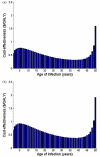Evaluating the cost-effectiveness of rabies post-exposure prophylaxis: a case study in Tanzania
- PMID: 19925948
- PMCID: PMC3272373
- DOI: 10.1016/j.vaccine.2009.09.027
Evaluating the cost-effectiveness of rabies post-exposure prophylaxis: a case study in Tanzania
Abstract
Although fatal if untreated, human rabies can be prevented through post-exposure prophylaxis (PEP), which involves a course of vaccination and immunoglobulin administered immediately after exposure. However, high costs and frequent lack of rabies vaccine and immunoglobulin lead to about 55,000 deaths per year worldwide. Using data from a detailed study of rabies in Tanzania, we calculate a cost-effectiveness ratio for PEP when the WHO-recommended Essen regimen, a 5-dose intramuscular vaccination schedule, is adopted. Our analyses indicate a cost-effectiveness ratio for PEP of $27/quality-adjusted life year (QALY) from a health care perspective and $32/QALY from a societal perspective in Tanzania. From both perspectives, it is "very cost-effective" to administer PEP to patients bitten by an animal suspected to be rabid. Moreover, PEP remains "very cost-effective" provided that at least 1% of doses are administered to people who were actually exposed to rabies.
Figures






Similar articles
-
The potential effect of improved provision of rabies post-exposure prophylaxis in Gavi-eligible countries: a modelling study.Lancet Infect Dis. 2019 Jan;19(1):102-111. doi: 10.1016/S1473-3099(18)30512-7. Epub 2018 Nov 21. Lancet Infect Dis. 2019. PMID: 30472178 Free PMC article.
-
Health economic assessment of a rabies pre-exposure prophylaxis program compared with post-exposure prophylaxis alone in high-risk age groups in the Philippines.Int J Infect Dis. 2020 Aug;97:38-46. doi: 10.1016/j.ijid.2020.05.062. Epub 2020 May 22. Int J Infect Dis. 2020. PMID: 32450291
-
Cost-effectiveness of rabies post exposure prophylaxis in Iran.J Res Health Sci. 2014 Spring;14(2):122-7. J Res Health Sci. 2014. PMID: 24728746
-
Overview of rabies post-exposure prophylaxis access, procurement and distribution in selected countries in Asia and Africa, 2017-2018.Vaccine. 2019 Oct 3;37 Suppl 1(Suppl 1):A6-A13. doi: 10.1016/j.vaccine.2019.04.024. Epub 2019 Aug 27. Vaccine. 2019. PMID: 31471150 Free PMC article. Review.
-
Cost-effectiveness modelling studies of all preventive measures against rabies: A systematic review.Vaccine. 2019 Oct 3;37 Suppl 1:A146-A153. doi: 10.1016/j.vaccine.2018.11.071. Epub 2018 Dec 13. Vaccine. 2019. PMID: 30554795
Cited by
-
Estimating the burden of rabies in Ethiopia by tracing dog bite victims.PLoS One. 2018 Feb 21;13(2):e0192313. doi: 10.1371/journal.pone.0192313. eCollection 2018. PLoS One. 2018. PMID: 29466403 Free PMC article.
-
One Health approach to cost-effective rabies control in India.Proc Natl Acad Sci U S A. 2016 Dec 20;113(51):14574-14581. doi: 10.1073/pnas.1604975113. Proc Natl Acad Sci U S A. 2016. PMID: 27994161 Free PMC article.
-
Effect of counselling on health-care-seeking behaviours and rabies vaccination adherence after dog bites in Haiti, 2014-15: a retrospective follow-up survey.Lancet Glob Health. 2017 Oct;5(10):e1017-e1025. doi: 10.1016/S2214-109X(17)30321-2. Lancet Glob Health. 2017. PMID: 28911750 Free PMC article.
-
Thresholds for the cost-effectiveness of interventions: alternative approaches.Bull World Health Organ. 2015 Feb 1;93(2):118-24. doi: 10.2471/BLT.14.138206. Epub 2014 Dec 15. Bull World Health Organ. 2015. PMID: 25883405 Free PMC article.
-
A cross-sectional study of awareness and practices regarding animal bites in rural community, North India.J Family Med Prim Care. 2020 Jun 30;9(6):2751-2757. doi: 10.4103/jfmpc.jfmpc_158_20. eCollection 2020 Jun. J Family Med Prim Care. 2020. PMID: 32984120 Free PMC article.
References
-
- Dhankhar P, Vaidya SA, Fishbien DB, Meltzer MI. Cost effectiveness of rabies post exposure prophylaxis in the United States. Vaccine. 2008;26(August (33):4251–5. - PubMed
-
- Manning SE, Rupprecht CE, Fishbein D, Hanlon CA, Lumlertdacha B, Guerra M, et al. Human rabies prevention—United States, 2008 recommendations of the Advisory Committee on Immunization Practices. MMWR Recomm Rep. 2008;57(May (RR-3):1–28. - PubMed
Publication types
MeSH terms
Substances
Grants and funding
LinkOut - more resources
Full Text Sources
Medical
Miscellaneous

